Neutrino masses at CERN’s Large Hadron Collider - from theory to data
Present time is tough… really tough… And I don’t speak about the market status (even if I could). Although my COVID sickness period is now behind me, I am currently living in a kind of permanent state of extreme fatigue. No matter what I do, I get exhausted. Anyway, I will hopefully go through it… at least at some point.
In the meantime, here is a new physics blog. The topic of the day is related to neutrino physics. In fact, I would like to use this blog as an illustration of how a theoretical idea is first proposed, then tested on simulations and how it eventually ends up being applied to real life (i.e. tested in data).
As known for quite a while (and discussed in this older blog), neutrinos provide a clear sign of phenomena beyond the Standard Model of particle physics. We indeed have several proofs that neutrinos are massive, and in the Standard Model they are modelled without a mass. This consists thus of an outstanding contradiction, that gives physicists a good reason to investigate how neutrinos could get massive.
In 2020, together with a handshake of collaborators, we proposed a new idea to test neutrino mass models (see also this blog). Last month, the CMS collaboration from CERN’s Large Hadron Collider (the LHC) released a new study in which they have applied this idea directly to data. As a theoretical particle physicist, that’s one of the greatest successes that can be achieved: we propose something that our experimental colleagues find interesting enough (or cool enough, because physics is cool, isn’t it?) to be tested against data.
Reading this news from CMS pleased me quite a while, so that I decided to dedicate a blog on this event. This provides a good opportunity to show two versions of the same plot (at the end of the blog): the one made by us with simulations, and the one that CMS released. Please hodl your breath (I know, this joke is stupid, but I could not resist)…
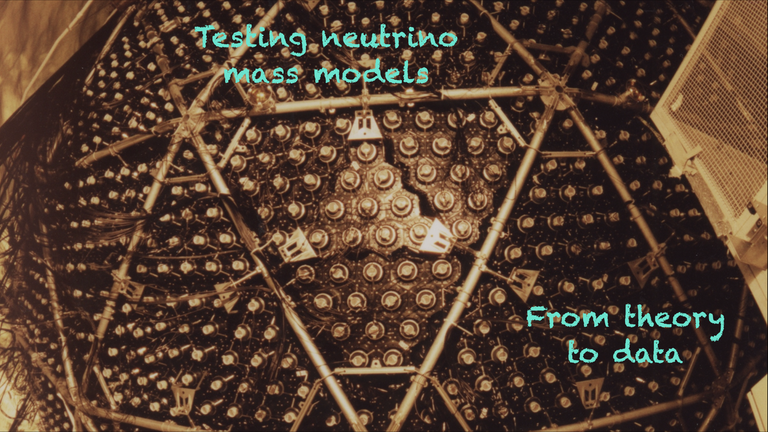
[Credits: Original image from SNO (CC BY-SA 4.0)]
Before moving on, I would like to make a special mention to our citizen science particle physics project on Hive. The goal of our project is very similar to the topic discussed in this blog: we plan to adapt the study proposed in 2020 to other neutrino signatures and assess the potential of the LHC relative to the changes. If we find promising results, then maybe they will trigger new experimental studies in a few years… At least this is my dream (and my reality…)!
For those who are scared by physics but would like to to learn a few things, feel free to jump directly to the last section of this blog (although you may enjoy the next section that includes a friendly introduction to neutrinos). For the others, please enjoy this new excursion in my world. I start with some basics about neutrinos before discussing neutrino mass models and their neutrinoless tests.
Isn’t this cool? We proposed a test of neutrino masses without using neutrinos at all! This has to be cool, there is no way out (please contradict me… if you dare ;) ).
Neutrinos - from their discovery to today, in a nutshell
This blog is all about neutrinos. Therefore, it is good to start the discussion with a definition and details on neutrinos.
Those little beasts are quite old, and we can track them initially in the first half of the 20th century. At that time, physicists were having fun with radioactive atomic nuclei, and were observing so-called beta decays. In those processes, a given atomic nucleus decays into another nucleus carrying an electric charge that is one unit higher. This decay is accompanied by the emission of an electron. Or at least, this is what was seen back in the days.
If we check carefully the properties of this electron, we can immediately conclude that it is a wild weirdo. The energy carried away by this electron is in total disagreement with the most golden rule of physics ever: energy conservation. A crazy explanation was proposed by Wolfgang Pauli: electrons are not emitted alone during beta decay processs, but together with an invisible object (coined later a neutrino).
Consequently, the energy available in the reaction is shared between the electron and the invisible particle, and agreement with relativity is recovered. Pfeew... Our understanding of the world almost collapsed… However, it didn’t (thank you neutrinos!).
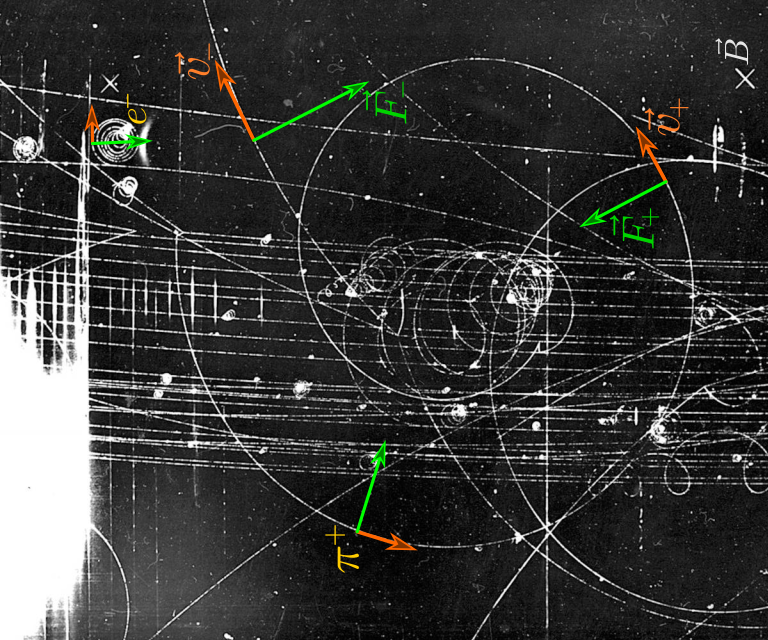
[Credits: Ponor (CC BY-SA 4.0)]
60-70 years later, not only neutrinos were observed, but we also know (for sure thanks to observations) that our universe is equipped with three neutrino species. The Standard Model of particle physics indeed includes three types of massless neutrinos called the electron neutrino, the muon neutrino and the tau neutrino.
However, nature is the trickiest of our friends. At the end of the 1990s and beginning of the 2000s, the results of the Sudbury Neutrino Observatory in Canada and those of the Super-Kamiokande detector in Japan were released: a neutrino of a given nature can turn in a neutrino of another nature when it propagates. For instance, this means that an electron neutrino emitted at a given place in the universe can be observed as an electron neutrino, a muon neutrino or a tau neutrino on Earth. All options are possible!
This fact was a game changer, contradicting all expectations from the Standard Model. The reason is that this ‘oscillations’ business is not compatible with the fact that neutrinos are massless. In other words, this observation demonstrated clearly that neutrinos are massive! The Standard Model is thus not the end of the story (and this is good for people like me, as this means we have some work to do).
Before moving on with this blog, here is a picture of a donut… There is a connection with the topic; feel free to use your Internet skills to find out which one.
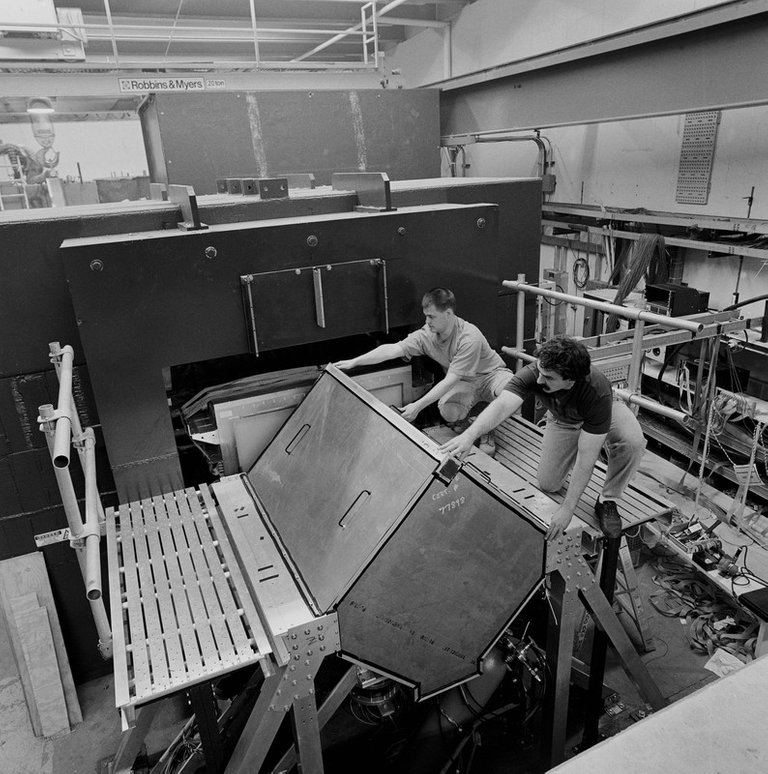
[Credits: Fermilab]
Neutrinoless probes of neutrino mass models at the LHC
The standard theory must therefore be modified to accommodate neutrino masses.
There is no unique way to do so, and data is for the moment still quite obscure (I was tented to write ‘dark’… but I promised not to discuss dark matter this time). Consequently, we don’t know what is the exact path to follow to extend the Standard Model and include neutrino masses in it. This encourages us to be pragmatic and test as many neutrino mass models as possible, which is where our story starts to get really, really cool.
Among all existing neutrino mass models, one of them postulates the existence of heavy neutrinos, much heavier than any particle of the Standard Model. Here, we thus minimally modify the Standard Model and add to it new massive neutrinos. These are in addition insensitive to any of the fundamental interactions.
All neutrinos (the old and the new ones) then mix, and this mixing provides masses to everybody. Some of the resulting neutrino admixtures are extremely light (the three neutrinos that we know) and the others are quite heavy (the ones that still need to be observed).
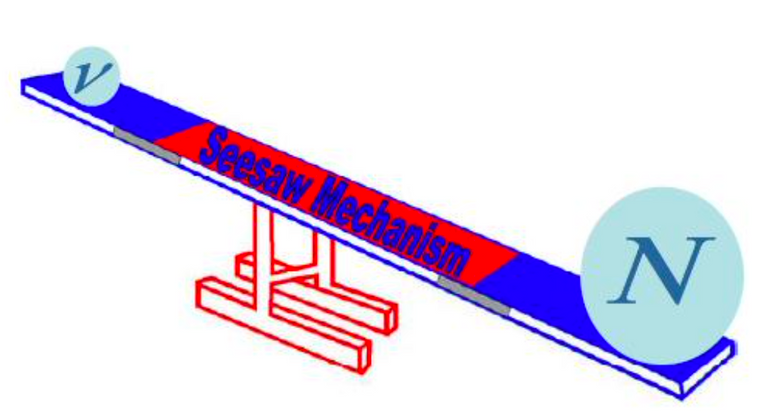
[Credits: J.Mod.Phys. 4 (2013) 7-10]
This mechanism is called the seesaw mechanism, nicely illustrated by the figure above. Let’s be honest: this is a nice illustration, isn’t it? The big fat neutrino N shares some of its mass with the (initially massless) Standard Model neutrino 𝞶.
We are now left to get very close to my 2020 work. With my collaborators, we focused on an LHC process called a neutrinoless double-beta process. This fancy name finds its roots in the beta decays of the 20th century described at the very beginning of this blog. First, as two is always better than one, a double beta process corresponds to a collider process in which two electrons are emitted. Second, it is neutrinoless, so that it means there is no neutrino emitted together with the electrons.
In seesaw models, such a situation could originate from the exchange of heavy neutrinos, like in the diagram below. This figure can be read as follows. We start on its left, where we can see two quarks q1 and q2. They are two of the constituents of the protons that collide in the LHC.
We thus have two quarks, that carry a lot of energy (protons are accelerated a lot at the LHC, so that their constituents are accelerated too). By virtue of weak interactions, they can convert into other quarks (the ‘primed’ quarks on the right), together with the emission of two energetic W bosons (that we see in purple in the middle of the figure).
Those two W bosons then lead to the emission of two charged leptons l1 and l2, that could be either two electrons, or two positrons, or two muons, or two antimuons, etc. This proceeds via the exchange of a heavy neutrino N.
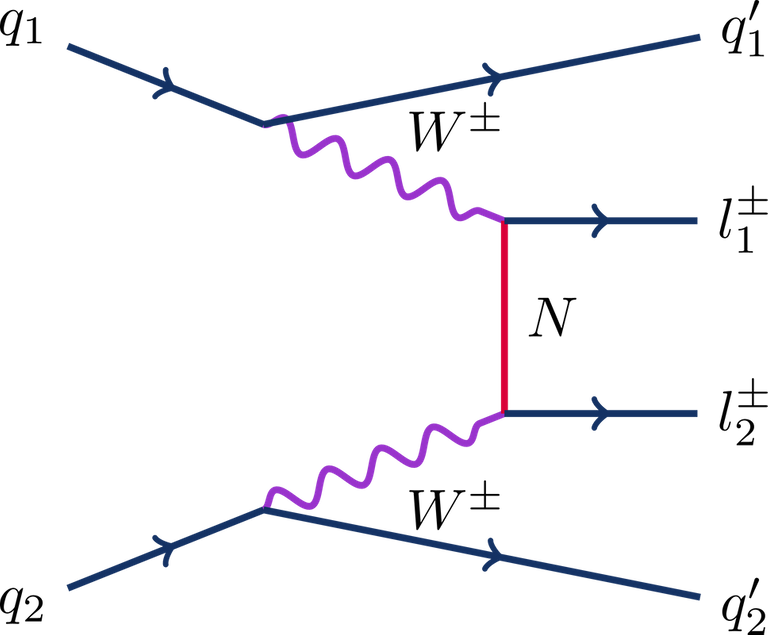
[Credits: CMS-EXO-21-003 (CMS @ CERN)]
This process is very interesting because it leads to the production of two leptons of the same electric charge (like two muons or two positrons), and no neutrinos. This signature is associated with a tiny amount of background of the Standard Model, so that observing it would consist of a clear sign of physics beyond the Standard Model.
Testing neutrino mass models - from theory to data
The important fact is that in the process discuss above, there is a heavy neutrino in the middle. Therefore, the signal depends on the underlying seesaw model, and of its parameters. Equivalently, this means that a study of the production of two leptons of the same charge at the LHC could allow us to test and probe seesaw models.
This is exactly what we proposed in our study in 2020, and what CMS did earlier this year. I will now very proudly show our predictions, and compare them with the findings from CMS…
To fix the ideas, we focus on the production of two muons (this was our proof of concept, that CMS followed as well). In contrast, our #citizenscience project on Hive focuses on other possibilities. The two figures depict the mass of the heavy neutrino on its X axis, and how this heavy neutrino mixes with the muon neutrino on the Y axis (1 corresponds to a mixing of 100%).
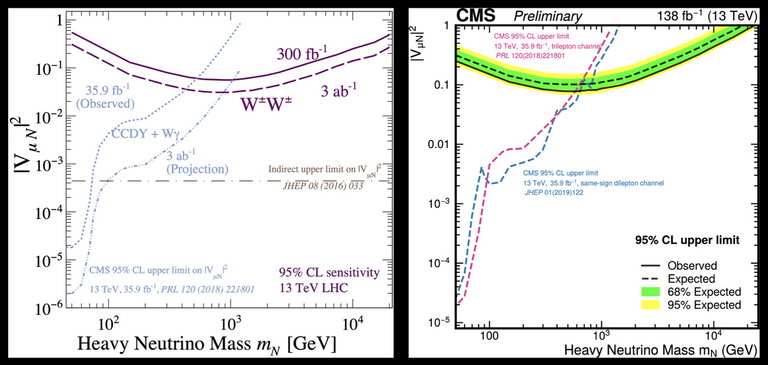
[Credits: Phys. Rev. D103 (2021) 055005 (CC BY 4.0; left figure) and CMS-EXO-21-003 (CMS @ CERN; right figure)]
The (almost vertical) blue dashed lines in the left figure and blue/pink dashed lines in the right figure correspond to older studies. Everything above those lines is excluded. Those limits being extracted from different analyses, they are only qualitatively similar. The conclusions are however the same: we exclude heavy neutrinos with masses ranging up to 1000 GeV (that’s 1000 times the mass of the proton), provided that they strongly mix with the muon neutrino (i.e. with a mixing parameter close to 1).
The interesting lines are the (almost horizontal) purple solid line in the left figure, which correspond to our predictions showing how heavy neutrinos could be probed with the above neutrinoless double-beta process. The amazing feature is that the lines extend deeply into the high mass regime. We can see that heavy neutrino with a mass of 20,000 GeV can be reached. This is almost twice the energy of the LHC!
Neutrinoless probes thus allow us to enter a regime in which heavy neutrinos are too heavy to be directly produced at the LHC!
The final excitement comes after comparing the solid purple line to the solid black line of CMS (within the green-yellow band in the right figure). The observation by CMS is in great agreement with our predictions! In other words, we demonstrated the feasibility of an analysis in 2020, and CMS then decided to check it out in data. CMS confirmed our predictions and the potential of neutrinoless probes to test neutrino mass models.
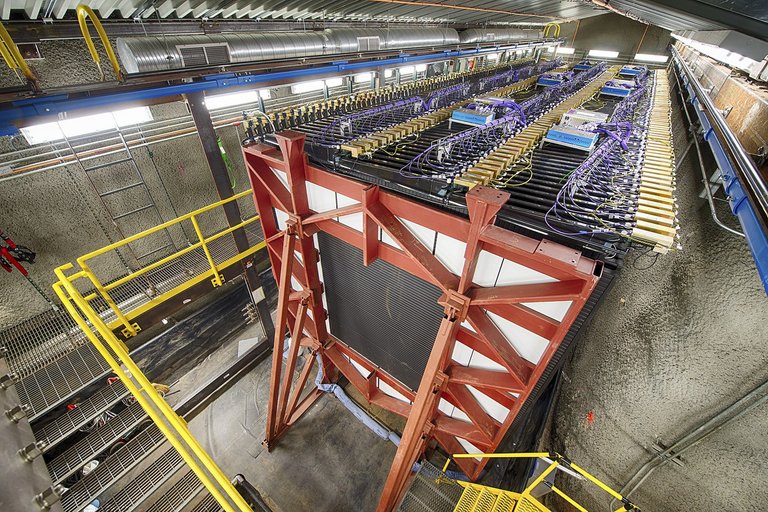
[Credits: Reidar Hahn (public domain)]
Take home message: neutrinoless probes of neutrino masses in theory and in data
Neutrinos were initially proposed in the 1930s to explain anomalies in radioactive decays in which an electron was emitted. Since that moment, they have been observed, and we figured out that there are three species of neutrinos in the Standard Model: the electron neutrino, the muon neutrino and the tau neutrino.
Whereas those three neutrinos are predicted massless, data from the end of the last millenium showed that this was actually not true. There must therefore be some new particles beyond the Standard Model that could explain why neutrinos are massive. In the present blog, we focused on so-called seesaw models, in which the neutrinos of the Standard Model acquire their mass through the mixing with inert heavy neutrinos.
In 2020, together with collaborators, we have proposed a new signature of those seesaw models, in which two leptons of the same electric charge could be produced without any neutrinos at particle colliders. This signal has a great advantage: the background from the Standard Model is small, so that there are good prospects for its observation.
In the study my collaborators and I performed, we demonstrated that such a process could allow us to probe heavy neutrinos with masses ranging up to almost twice the LHC energy at the LHC.
Last month, the CMS collaboration released the results of a new analysis in which they shown that our predictions… were actually very accurate ones. Neutrinos as heavy as promised could in principle be observed. However, there was no signal. The CMS analysis therefore did not lead to a discovery, but to constraints on seesaw models.
The story is however not over, and the hunt for new phenomena continues!
I hope you enjoyed this blog. I tried to make it shorter than usual, to save my energy (thank you COVID). I apparently failed :-) Anyway, feel free to comment and ask questions!
By the way, I have not yet picked any topic for next week. Therefore, consider suggesting anything! Have a very good hodl/dupm week in the meantime!
https://twitter.com/BenjaminFuks/status/1537045790333538308
The rewards earned on this comment will go directly to the people(@lemouth) sharing the post on Twitter as long as they are registered with @poshtoken. Sign up at https://hiveposh.com.
I hope your fatigue clears up soon!
Make sure you engage in exercise and a healthy diet.
I wish you the best.
Thanks for passing by and for your nice words. I hope to get well soon too :)
I am trying to get exercised, but this is tough with the fatigue (my diet has always been fine). It is a bit like the cat that tries to catch its tail (too tired to exercise during a long period, and exercising for a short period exhausts me a lot). However, I definitely do that. That's the only way out!
Cheers!
My favorite exercise is this skiing-bike machine, an elliptical, they're called. They let you use your arms and legs to perform a really steady and gentle motion, which makes it easy to burn some calories.
The ability to use both your arms or legs, or both at the same time, gives you plenty of mid-exercise recovery options, to keep you going a bit longer than more harsh exercises can.
Mine is... mowing the lawn! I know, I am kind of old-school with this respect. But I really enjoy this, being outside, getting my weekly dose of D-vitamins, etc. In addition, this is a quite useful activity for the house.
I was in fac about to consider biking a bit during the week-end, but the temperature is planned to reach 40 Celsius... France is hit by a heat wave at the moment, and I therefore probably won't bike...
Do you eat enough? If you're not counting calories, you could easily, accidentally, start eating less for whatever reason, and that alone might cause fatigue. Add exercise, and now you need even more calories! (depending on whether your weight was okay to begin with).
I had a lost of appetite during the week I was COVID-positive. I guess my current state is originating from many sources: COVID recovery, heat wave, being a bit weaker than usual, etc. I guess I will slowly and slowly get back on tracks.
Cheers and thanks for asking! :-)
!1UP
Thank you!
You have received a 1UP from @luizeba!
@stem-curator, @vyb-curator, @pob-curator, @neoxag-curator, @pal-curatorAnd they will bring !PIZZA 🍕
Learn more about our delegation service to earn daily rewards. Join the family on Discord.
Thanks for your contribution to the STEMsocial community. Feel free to join us on discord to get to know the rest of us!
Please consider delegating to the @stemsocial account (85% of the curation rewards are returned).
You may also include @stemsocial as a beneficiary of the rewards of this post to get a stronger support.
Congratulations @lemouth! You have completed the following achievement on the Hive blockchain and have been rewarded with new badge(s):
Your next target is to reach 95000 upvotes.
You can view your badges on your board and compare yourself to others in the Ranking
If you no longer want to receive notifications, reply to this comment with the word
STOPI hope you get your energy back soon. I discovered the DONUT connection (thanks internet skills) just to prove I actually read the post. Your job is totally fascinating and you must really love it.
Thanks for passing by and writing this comment. Thanks to you, I now know for sure that at least one person read this blog. Mission accomplished! :-)
I indeed totally love my job, and all parts of it (as weird as this may sound). Whereas I have a (very) strong preference for research and teaching, administration is also (a big) part of the job. I cannot say that I love it, but this is a necessary component of the job and I find it definitely 'interesting'. At least, I learned new skills through it, and it allows to act in some way on the general picture of the local system (which is not bad per se).
Cheers!
I certainly did you that respect... I do like reading sciencey stuff and always wish I chose it over literature. You are lucky to be doing something you like....Bah, admin. Sadly has to be done!
Thanks once again! :)
Yep. There is no way out... In every job, there is always a less funny part that needs to be done.
This is what you produce with low energy??? Wow, you put the rest of us to shame. I am so sorry you are not bouncing back to your 'normal' self, but fatigue seems to be a hallmark of this virus for many. Try to suppress your ambition to explore and to know. You must rest :)
The blog, as always, is exciting. How gratifying it must be that the community of particle physicists has taken your idea (and that of your collaborators) and found it viable. You will forever be a link in the chain of discovery that explains contradictions in the Standard Model and moves on to creating a new 'Standard'. Will this not be the case? When does science move beyond the Standard Model? Or is this a kind of scientific heresy?
I personally think you are a frustrated writer. Your style is quite light and engaging, especially considering the weightiness (yes, neutrinos have mass: my joke) of your topic.
Be kind to yourself, @lemouth. I know you see precious time passing and fatigue robbing you of opportunity to explore and advance. But rest now, so you can do more later.
Be better soon....
Let's say that I rest efficiently. There are too many on-going issues (end of the year, etc.) so that I in fact must compensate the time I spend in resting (I have never taken a single day of sick leave since I have been hired in 2008).
That's definitely the best of the best. I was really happy to see this from the CMS collaboration, and I actually did not expect it at all. At that moment, I only knew that the ATLAS collaboration may do something soon. Now they will be second ;)
Well, for this we need first to discover something. At the moment, there is no signal, so that we can only put constraints on the parameters of the neutrino mass model. However this is how new knowledge is built. We explore all possibilities and see what survives data (and discoveries). Only after this we will be able to construct the next Standard Model. I just hope that I will see it during my lifetime.
That's interesting. This is true I really pay a lot of attention to the message I try to convey with my words, but I also like writing per se. I however don't see myself writing about anything else except (heavy, to continue your joke) science.
This being said, I believe that I should soon write a light post, as I reached a few milestones on chain recently (followers, HP). I however think that I will wait for reaching 20,000 comments. Then I may write such a light blog, which may happen right before I will leave for Canada ^^
Have a nice end of the week. Week-end starts soon (with 42 degrees Celsius planned here!).
!!!!
BTW: My daughter just came down with COVID. 😟
Oh no! I wish her a quick recovery, and of course no impact on her health on mid term / long term! Good luck!
😇
🌺
That's really a wonderful and exciting experience as a theoretical physicist! This is such a nice read, I was able to understand the concepts I was about to research on when I read your PRD paper (especially on the use of the illustration in explaining the seesaw mechanism). You should also consider compiling all these blogs and write a book, you're a very engaging writer. :)
Hope you get back soon to the healthier you (before getting Covid), I know some people who tried doing cardio exercises to get back their stamina. But also, rest is such a great investment too.
Here's a question I've got, what will be the implication of the observation of the CMS collaboration on the future work at the LHC? Since the prediction and observed data shows that the heavy neutrino is beyond the energy of the LHC?
Hmm I am not very sure about this. Somewhat, I should need to find a story line connecting 'smoothly' all my blogs, which is not always easy as the topics covered are quite different. And this story line needs to be attractive so that people could have fun to follow from A to Z. This is where I am for now not 100% sure.
Anyway, I will keep it in mind, maybe for the future. Also, I need to consider the time it will take to write such a book. As a side note, I already have two physics books published (in French, although one of them is currently being translated to English; we are ion negotiations with publishers).
For now, they have not observed any signal, so that constraints on the model are put. However, only a small fraction of the parameter space is excluded (what lies above the solid black line in the CMS plot), so that there is still a long way to go before we could say that we throw seesaw models to the bin. In other words, there is this still a lot of space for future searches to contribute.
On the other hand, the mass of the heavy neutrino is a free parameter of the model. It could be light (the left part of the plot, more constrained) or heavy (the right part of the plot). The nice feature/strength of the search that I discuss is that it allows us to probe configurations in which the mass of the neutrino is larger than the energy of the LHC, as well as configurations when it is small.
However, as can be seen from the results, the search only probes configuration where the mixing between the heavy neutrino and the Standard Model neutrinos is (very) large. There are thus still a lot of non-probed setups, that we must cover in the future in one way or the other.
Does it answer your question?
PS: the fatigue does not want to leave, unfortunately :(
Ah yeah, you're right, book writing and editing takes a lot of time and effort since it's a 'packaged' of discussions of a general topic.
Oh, this is great news. I actually started learning French 2 years ago, on the first months of the pandemic. But I'm still in the beginner's level. Haha. I'd just patiently wait for the translation of one of your books since I haven't even finished reading the book Le Petit Prince. 😅
There really are still so many things to explore! Somehow, it made me more excited knowing that there's still a lot of work needed to be done, as you have mentioned that this is also what we aim in the #citizenscience project.
As a side note, I discussed your suggestion with my wife, and she agrees with you. I should extract a book out of my blogs. I am still very unsure about this, and that's definitely too much work at the moment so that there is no reason to even ask the question ;). It is however well noted.
I will let you know when this translation will be finalised. It is a primer on quantum mechanics (so definitely too hard in French for someone not mastering the language).
I am late on this one. I should start finalising the next episode... But the end of the year is tough, as any end of the year ;)
Cheers!
Yay, another thing to look forward to in the future! :)
It's fine, slow progress is still progress. It's not good that the project will be overwhelming the participants and that includes you as our professor 😃
Thanks for these nice words :)
Watch out for the human traffickers at hivefest. You wont know it until its too late. STAY AWAY! Beware, traffickers can be women or men! They will act nice until they dont. There is human trafficking going on around this type of crypto. I have witnessed it. They literally have attempted my murder and are trying to kill me with V2K and RNM. Five years this has been happening to me, it started here, around people that are still here. Homeland security has done nothing at all, they are not here to protect us. Dont we pay them to stop shit like this? The NSA, CIA, FBI, Police and our Government has done nothing. Just like they did with the Havana Syndrome, nothing. Patriot Act my ass. The American government is completely incompetent. The NSA should be taken over by the military and contained Immediately for investigation. I bet we can get to the sources of V2K and RNM then. https://ecency.com/fyrstikken/@fairandbalanced/i-am-the-only-motherfucker-on-the-internet-pointing-to-a-direct-source-for-voice-to-skull-electronic-terrorism ..... https://ecency.com/gangstalking/@acousticpulses/electronic-terrorism-and-gaslighting--if-you-downvote-this-post-you-are-part-of-the-problem if you run into one of them you may want to immediately shoot them in the face. 187, annihilate, asphyxiate, assassinate, behead, bleed, bludgeon, boil, bomb, bone, burn, bury, butcher, cap, casket, choke, chop, club, crucify, crush, curb, decapitate, decimate, deflesh, demolish, destroy, devein, disembowel, dismember, drown, electrocute, eliminate, end, euthanize, eviscerate, execute, explode, exterminate, extinguish, finish, fry, grind, guillotine, gut, hack, hang, hit, ice, implode, incinerate, kill, liquidate, lynch, massacre, maul, microwave, mutilate, neutralize, obliterate, off, pop, poison, punnish, quarter, ruin, shank, shock, shoot, shred, skin, slay, slaughter, smoke, smother, snipe, snuff, squish, stab, strangle, stone, suffocate, suicide, SWAT, swing, terminate, torture, terrorize, whack, waste, wreck. You better fucking kill me.